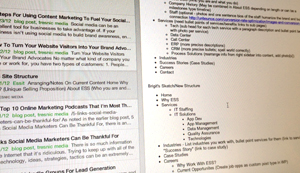
When you’re having a new website developed for your business, the first steps that should be taken by your web designer are researching the competition as well as the target audience. That way, they can structure the content of your site before designing the website’s layout. They will learn what is working in the industry and what your customers are interested in from you. It’s important to communicate that your business is here to help your customers and show them how you can solve their problems.
Why Content Should Be Planned Before Designing Your Website
If you don’t know what type of information you are going to need for the site or how to communicate that information, then you won’t be able to design the best website for your business specifically.
While having a beautiful website is great and can immediately convey professionalism, if your website doesn’t convert visitors into customers, then what good is it? That would be like hiring a handsome sales rep (on salary) to hang out in the office all day, playing on the Internet and he never brought in any new business for the company.
Always remember that your website should be an asset for your business, not an expense. Tweet This
Your website should be structured with a path in mind that you want the visitors to take. When they arrive on your home page, which pages they visit second, third and eventually leading them to a call to action page should all be mapped out. The best way to plan these website journeys is by matching them to the different levels of your sales funnel.
How To Find What Content You Should Have On Your Website
Think about what customers ask you most frequently when they are first in the market for your services. Answer those questions in blog posts or on the top-level service pages. Have your website visitors enter your website onto top of the funnel content pages and lead them through information related to the different stages of your buyer cycle.
After you’ve spoken with a customer and they are aware of what your business does and the services you offer, what are the next topics that they are interested in? Keep these questions in mind when you are working with your web designer on which pages you want on your website.
The natural progression of educating them will lead your visitors to becoming customers at a much higher conversion rate than just randomly publishing pages on your website that you as the business want to see.
Make Your Site Content For Your Customers, Not For Yourself
Remember that you are not your clients. Keep the information on your website relevant to what your prospective buyers want to know, not what you want to tell them. Skip any jargon because they don’t speak the same language as people in the industry. Try to think from their perspective. Better yet, ask them what they would want to see and then deliver it.
Call your best customers and ask them about their experience buying from you and what encouraged them to choose you over the competition. Use that information to highlight your key differentiators on your website. Find out what type of information your buyers need to know in order to close the sale and then provide that on your website. Not only will this increase your website conversion rates, but it will save your sales team time because by the time the customer calls your company, they have a lot of their questions answered already.
How Is Your Website Content Structured?
Is your website content intentionally structured? Do you map your user experience to your sales funnel? Let me know what your experience was with your website designer in determining what pages should be on your website and where they should be in the sites design and hierarchy. Leave comments below.
